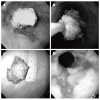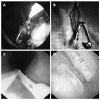Endoscopic management of foreign bodies in the upper gastrointestinal tract: A review
- PMID: 25324918
- PMCID: PMC4198392
- DOI: 10.4253/wjge.v6.i10.475
Endoscopic management of foreign bodies in the upper gastrointestinal tract: A review
Abstract
Foreign body ingestion is a common condition, especially among children who represent 80% of these emergencies. The most frequently ingested foreign bodies in children are coins, toys, magnets and batteries. Most foreign body ingestions in adults occur while eating, leading to either bone or meat bolus impaction. Flexible endoscopy is the therapeutic method of choice for relieving food impaction and removing true foreign bodies with a success rate of over 95% and with minimal complications. This review describes a comprehensive approach towards patients presenting with foreign body ingestion. Recommendations are based on a review of the literature and extensive personal experience.
Keywords: Endoscopic management; Esophageal stricture; Food bolus impaction; Foreign body; True foreign body.
Figures




References
-
- Webb WA. Management of foreign bodies of the upper gastrointestinal tract. Gastroenterology. 1988;94:204–216. - PubMed
-
- Kay M, Wyllie R. Pediatric foreign bodies and their management. Curr Gastroenterol Rep. 2005;7:212–218. - PubMed
-
- Waltzman ML, Baskin M, Wypij D, Mooney D, Jones D, Fleisher G. A randomized clinical trial of the management of esophageal coins in children. Pediatrics. 2005;116:614–619. - PubMed
-
- Macpherson RI, Hill JG, Othersen HB, Tagge EP, Smith CD. Esophageal foreign bodies in children: diagnosis, treatment, and complications. AJR Am J Roentgenol. 1996;166:919–924. - PubMed
-
- Roura J, Morelló A, Comas J, Ferrán F, Colomé M, Traserra J. Esophageal foreign bodies in adults. ORL J Otorhinolaryngol Relat Spec. 1990;52:51–56. - PubMed
Publication types
LinkOut - more resources
Full Text Sources
Other Literature Sources

